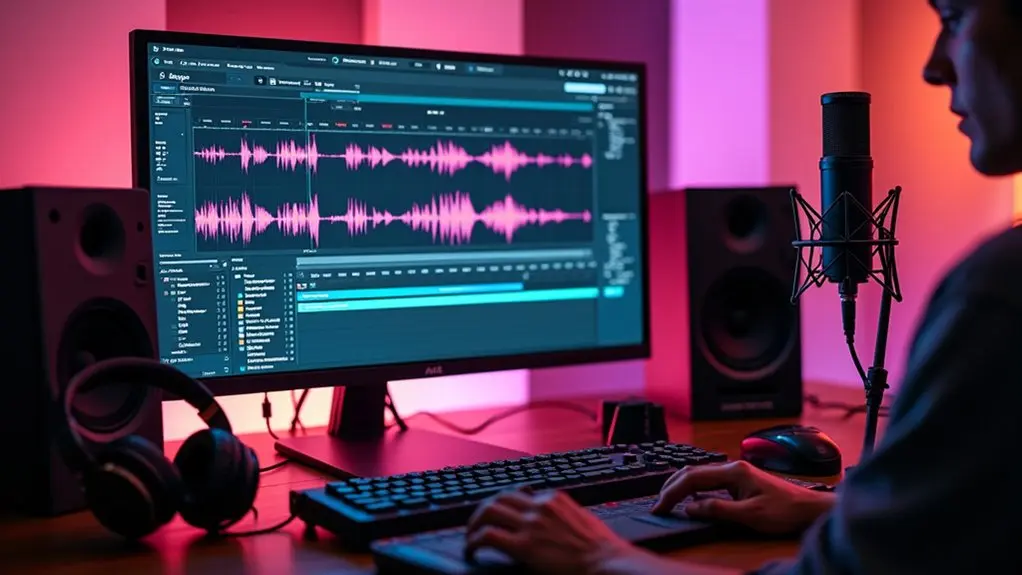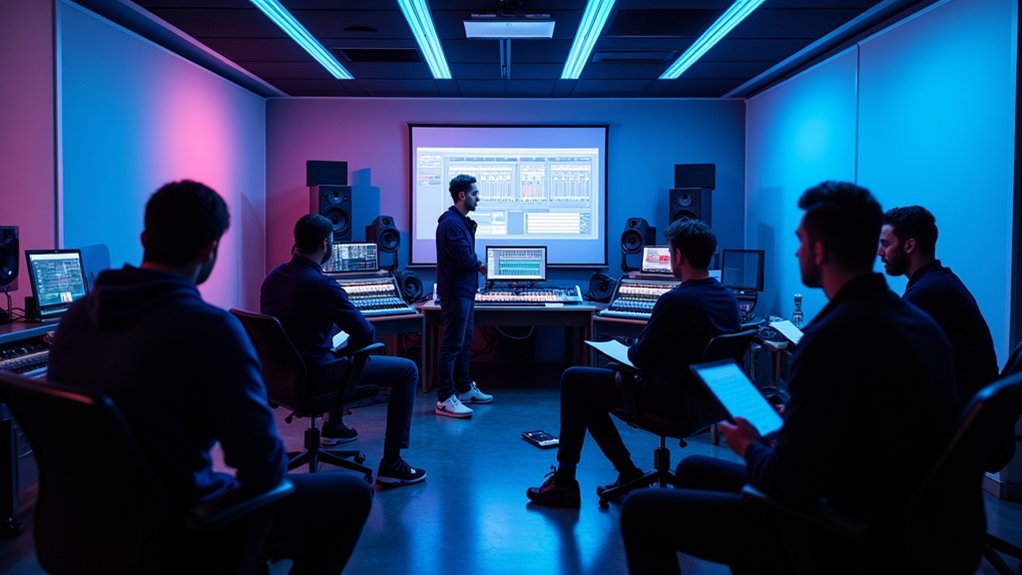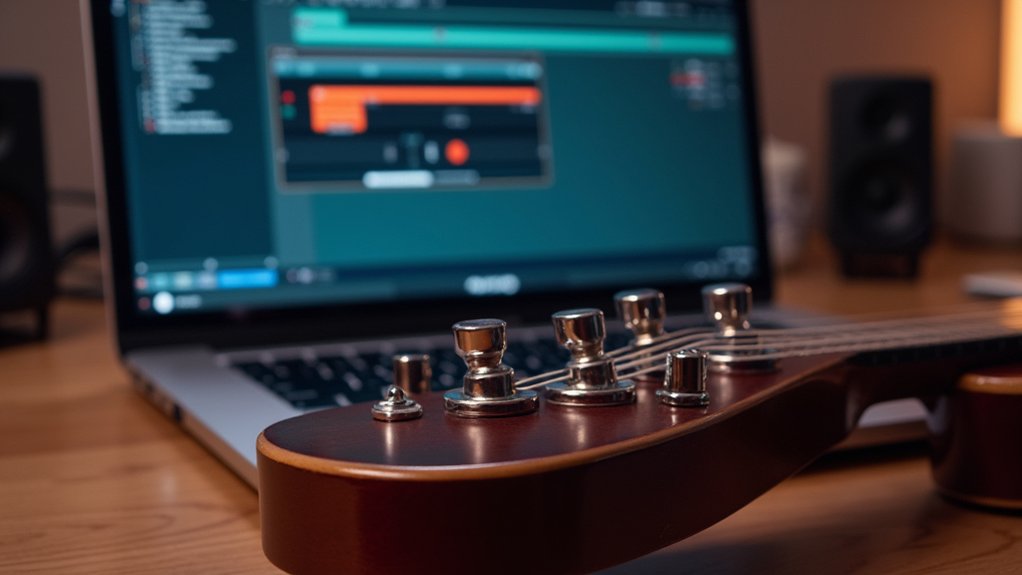Ableton Standard offers unlimited tracks and core effects suiting foundational production needs, while Suite expands with 70+ audio effects, 17 instruments, advanced sound libraries, and Max for Live integration—ideal for professionals demanding deep sound design and workflow customization. Price and long-term creative scope should guide selection; Standard prioritizes cost-effective essentials, whereas Suite fosters technical fluency and generative composition. Exploring further reveals detailed comparisons of instruments, workflow enhancements, and value considerations for discerning producers.
Key Takeaways
- Suite offers more instruments, effects, and 30GB+ of sound libraries, while Standard provides essential tools for core music production at a lower cost.
- Suite includes Max for Live for advanced customization and generative tools, ideal for professionals or experimental producers seeking deep creative control.
- Standard is best for beginners or producers focused on songwriting and basic production, providing unlimited tracks and 35 built-in effects.
- The upgrade from Standard to Suite costs $295, so consider your budget and whether you’ll use Suite’s exclusive features regularly.
- Choose Suite for advanced sound design, unique workflows, and long-term creative growth; pick Standard for foundational production and a gentler learning curve.
Core Features Compared: Standard Vs Suite
While both Ableton Live Standard and Suite editions deliver robust digital audio workstations for music production, their core feature sets diverge markedly in depth and scope.
In the Standard vs Suite version assessment, Standard offers fundamental professional tools, such as unlimited audio and MIDI tracks, and compatibility with VST2, VST3, and Audio Unit plugins.
However, the Suite version extends these capabilities with advanced integration, especially Max for Live, granting users the power to engineer bespoke devices and workflows.
Suite also more than doubles the array of audio effects—over 70 compared to Standard’s 35—substantially broadening audio manipulation potential.
Additionally, Suite provides an expanded library exceeding 30GB, facilitating advanced sound design.
The introduction of Meld and Granulator III in Suite further enhances creative possibilities with MPE support, expanding the sonic palette for composers and producers.
These distinctions position Suite as the more all-encompassing, future-proof solution for demanding creative environments.
Instruments and Effects: What Do You Get?
Building upon the distinctions in core features, a detailed examination of instruments and effects reveals further divergence between Ableton Live Standard and Suite.
The Standard edition delivers 23 audio effects, including production essentials like EQ8 and Glue Compressor, while the Suite acts as an Upgrade Kit, releasing over 30 additional audio effects and a thorough palette of synthesis and processing tools.
For advanced users, Suite’s integration of Max for Live extends the platform with customizable instruments and effects, dramatically broadening creative potential.
Key comparative highlights include:
- Instrument Availability: Suite introduces advanced synthesizers such as Operator and Wavetable, absent in Standard.
- Effects Inventory: Suite offers 35+ audio effects, surpassing Standard’s essential toolkit.
- Customization: Only Suite supports Max for Live, enabling bespoke device creation and experimental workflows.
- Suite’s additional tools include FabFilter Pro-Q 3 for precise frequency adjustments, enhancing mix clarity.
Sound Libraries and Packs Breakdown
Sound content serves as a pivotal differentiator between Ableton Live Standard and Suite, shaping the scope of creative resources available to producers. The Standard edition provides 23 sound libraries, encompassing essential instruments and genre-focused packs, sufficient for foundational production workflows. By contrast, Suite is worth considering for users seeking expansive sonic palettes; it delivers over 30GB in additional sound libraries and exclusive curated packs like “Beat Tools” and “Chop and Swing.” These packs offer advanced presets, recorded samples, and genre-specialized effects, optimizing workflow efficiency and creative flexibility. In addition, Suite’s integration of advanced instruments amplifies sound design capabilities, enabling intricate manipulation and synthesis. The Granulator III included in Suite offers advanced granular synthesis for innovative sound texture manipulation, enhancing the creative possibilities for sound design. The following table contrasts key aspects:
| Edition | Sound Libraries | Exclusive Packs |
|---|---|---|
| Standard | 23 | Core genre-focused |
| Suite | 30GB+ extra | Beat Tools, Chop/Swing |
| Both | Essential content | Golden Era, Trap Drums |
Max for Live: Unlocking Creative Potential
Max for Live, exclusive to Ableton Live Suite, empowers users with a modular framework for constructing custom instruments, facilitating highly specialized sound design workflows. Its architecture supports the development of advanced performance tools and bespoke audio effects, surpassing the capabilities of the core Ableton platform. This environment fosters procedural innovation, enabling creators to manipulate sonic parameters at an unparalleled level of granularity. Additionally, Max for Live integrates Max/MSP within Ableton Live, allowing for custom device creation and real-time sound manipulation.
Custom Instrument Creation
Harnessing the modular capabilities of Max for Live, users are empowered to engineer custom instruments and effects that transcend the standard offerings of Ableton Live.
Max for Live’s environment facilitates granular control over signal flow, parameter mapping, and algorithmic sound generation, making it indispensable for advanced sound design and experimentation.
Through custom instrument creation, users can:
- Develop bespoke devices—Design synthesizers or audio processors tailored to specific sonic requirements, utilizing both visual programming and code-based customization.
- Integrate third-party libraries—Access a vast ecosystem of user-contributed Max for Live devices, expanding beyond factory content while remaining cost-effective.
- Interface with hardware—Seamlessly bridge external controllers, sensors, or modular systems, enabling complex hybrid setups.
Proficiency in Max for Live consequently reveals sophisticated creative workflows unavailable in Ableton Standard.
Advanced Performance Tools
Building upon the capabilities afforded by custom instrument creation, the integration of Max for Live within Ableton Live Suite fundamentally redefines the terrain of live performance and real-time music manipulation.
Max for Live grants access to an expansive ecosystem of advanced performance tools, encompassing thousands of third-party devices that extend beyond conventional DAW functionality. Users can architect bespoke MIDI utilities, generative sequencers, and dynamic modulators, facilitating granular control over every parameter in a performance context.
This modular environment empowers producers to construct intricate, adaptive workflows, optimizing live setups and enabling innovations such as algorithmic composition and reactive audio manipulation.
While the learning curve for programming in Max for Live is considerable, its utility in crafting customized, performance-centric solutions is indispensable for artists seeking to push creative and technical boundaries.
Unique Audio Effects
Creative latitude within Ableton Live Suite is greatly augmented by the inclusion of Max for Live, which facilitates the conception and deployment of unique audio effects well beyond the scope of native devices.
This modular environment empowers users to construct custom audio effects, manipulate signal flow, and integrate advanced modulation schemes. Max for Live offers a robust platform for both bespoke device creation and access to a continually expanding library of user-generated effects, dramatically enhancing the arsenal available for sound design and live performance.
Key advantages include:
- Custom Device Engineering: Users can program intricate audio effects precisely tailored to their workflow.
- Advanced Modulation Capabilities: Max for Live introduces sophisticated modulation devices, enabling granular control over effect parameters.
- Expansive Device Library: Immediate access to a vast repository of third-party and community-driven audio effects.
Workflow Enhancements in Each Edition
Efficiency defines the user experience in both Ableton Live Standard and Suite, as each edition facilitates seamless arrangement and production with unlimited audio and MIDI tracks.
Workflow enhancements are apparent in the streamlined interface, enabling rapid navigation and manipulation of complex arrangements. The Standard edition’s 35 audio effects deliver essential processing tools, establishing a robust foundation for creative manipulation.
Suite introduces additional features, especially 16 more audio effects, seven extra software instruments, and over 30GB of sound libraries, substantially broadening the sonic palette and expediting advanced sound design tasks.
Suite’s integration of Max for Live further augments workflow by allowing deep system customization, user-generated devices, and tailored effect chains, empowering producers to create bespoke production environments that optimize efficiency and accommodate intricate creative demands.
In comparison, Reaper offers unmatched track flexibility and extensive plugin compatibility, which appeals to users looking for advanced customization options and comprehensive plugin support.
Performance and MIDI Tools in Depth
A thorough examination of Ableton Live’s performance and MIDI toolsets reveals distinct advancements between the Standard and Suite editions, particularly in live control and generative composition capabilities. Suite extends Standard’s core offerings with advanced packs that optimize real-time manipulation and sequencing. The Performance Pack introduces global control assignments and snapshot recall, enabling rapid configuration changes and robust live setups. Macro Page functionality closely emulates hardware controller layouts, streamlining multi-parameter automation during complex performances. For MIDI Tools, Suite’s exclusive packs introduce sophisticated pattern generation and sequencing options. Key differentiators include:
- Performance Pack: Real-time global controls and snapshot recall for dynamic live workflows.
- MIDI Tools Pack: Rhythmic/melodic generators for evolving, algorithmic MIDI performances.
- Sequencer Pack: Emulates classic step sequencing, expanding creative MIDI programming.
These features highlight Suite’s superiority for advanced live and MIDI-centric workflows. Additionally, Advanced Techniques in Ableton Live courses can further enhance one’s understanding of intricate warping methods and sound manipulation techniques, which are essential for maximizing the potential of Ableton Suite’s capabilities.
Sound Design Capabilities: Who Wins?
When evaluating sound design capabilities, Suite distinguishes itself with advanced synthesis engines, expanded audio effects, and a considerably larger sound library.
In contrast, Standard provides foundational instruments suitable for essential production tasks but lacks the modular flexibility offered by Suite’s toolset.
The presence of Max for Live and specialized devices in Suite grants users a vastly superior platform for intricate sound sculpting and experimental workflows.
Additionally, Suite’s inclusion of the Ableton Sampler, with its extensive sound manipulation options and versatile playback modes, enhances its capability for dynamic sound design.
Suite’s Advanced Sound Tools
Suite’s arsenal of advanced sound tools establishes a decisive edge in sound design over the Standard edition, utilizing an extensive 30GB sound library expansion, exclusive instrument collection, and unparalleled effect processing capabilities.
Suite’s inventory includes industry-acclaimed devices such as Operator and Wavetable, which enable advanced FM, subtractive, and wavetable synthesis for intricate sound design workflows. The integration of Max for Live further extends Suite’s creative potential, facilitating the development of custom instruments and effects.
Significantly, Suite delivers a wider selection of effects and instruments—such as Granulator III and Meld—unavailable in Standard, empowering experimental sound manipulation.
- 30GB Additional Library: Vast expansion for inspiration and sonic depth.
- Exclusive Instruments: Operator, Wavetable, Granulator III, Meld, and more.
- Max for Live Integration: Custom device creation for limitless sound design.
Standard’s Essential Instruments
While Ableton Live Standard equips users with foundational instruments such as Drum Rack, Impulse, Instrument Rack, and Simpler, its sound design capabilities remain inherently utilitarian.
These core devices facilitate sample layering, basic synthesis, and efficient workflow management, catering to users seeking streamlined production processes. Standard’s instrument suite supports essential sound sculpting, yet it inherently restricts advanced timbral manipulation and synthesis architectures, as its toolkit lacks the robust modulation matrices and granular processing engines present in Suite.
For beginners or those content with fundamental electronic music production, Standard’s offerings suffice. However, sound designers pursuing intricate sonic exploration may soon encounter limitations, prompting consideration of an upgrade.
Ultimately, Standard provides a competent platform for essential sound design, but Suite’s expanded instrument arsenal decisively outpaces it in technical versatility.
Target Users: Which Edition Fits Your Needs?
How does one determine the ideal Ableton Live edition for their workflow? The choice between Standard or Suite hinges on user profile, production objectives, and willingness to invest in advanced features.
Standard appeals to novices and hobbyists, offering a robust yet accessible platform with essential tools, unlimited tracks, and a moderate upgrade price. In contrast, Suite is engineered for professionals demanding thorough sound design, Max for Live customization, and an expansive 30GB sound library.
Consider the following:
- Entry-Level Producers: Standard is favorable, balancing core functionality with cost-effectiveness.
- Advanced Users/Professionals: Suite provides deep synthesis, custom device creation, and extensive libraries for complex production demands.
- Upgrade Trajectory: Those anticipating future growth may weigh the upgrade price from Standard to Suite against long-term requirements.
Ableton Live supports advanced multitrack MIDI editing and real-time clip manipulation, advantageous for live performances and electronic music production.
Careful alignment with production ambition guarantees favorable value.
Price, Value, and Upgrade Considerations
Given the substantial feature differential between Ableton Live Standard and Suite, cost-benefit analysis becomes paramount for discerning producers.
The upgrade price of $295 from Standard to Suite accesses an expansive arsenal: over 30GB of additional sound libraries, seven sophisticated instruments—including Operator and Wavetable—and 16 supplemental audio effects, in addition to Max for Live integration.
This augmentation greatly enhances production capabilities, representing considerable value for power users who require advanced sound design and creative flexibility.
However, price sensitivity remains pertinent, as regional variability and occasional promotional discounts may influence the overall investment.
For those prioritizing maximal toolsets and long-term workflow efficiency, the Suite edition’s all-encompassing offerings justify the higher price point by minimizing future upgrade constraints and maximizing return on investment within professional production environments.
New users transitioning from Ableton Live Lite may find the intuitive design helpful, offering a quicker learning curve and foundational understanding before upgrading to more advanced versions.
How to Decide Which Ableton Version Is Right for You
Selecting the ideal Ableton version necessitates a critical evaluation of production objectives, financial constraints, and anticipated growth in creative complexity.
Users must align their immediate functional requirements with longer-term aspirations, weighing the cost-benefit ratio of advanced features against budgetary realities.
The decision ultimately hinges on whether the extended capabilities of Suite offer proportional value for intended workflows and evolving artistic ambitions.
Assessing Your Production Goals
When evaluating which Ableton Live version aligns best with one’s production trajectory, a critical assessment of both current skill level and future ambitions is indispensable.
The Standard edition suffices for foundational production goals, offering expansive track capability and a robust suite of audio effects. However, for those targeting advanced sound design or customized workflows, Suite’s additional instruments and Max for Live integration may be worth the extra investment.
To determine the ideal version, consider:
- Skill Progression: Beginners may find Standard’s streamlined environment conducive, while experienced users may exploit Suite’s advanced architecture.
- Desired Creative Scope: Those envisioning intricate arrangements or unique soundscapes will benefit from Suite’s extended toolset.
- Long-Term Aspirations: If evolving towards professional production or live performance, Suite’s extensive features enhance creative potential and workflow flexibility.
Budget Versus Feature Needs
While financial constraints often shape software acquisition decisions, a nuanced evaluation of Ableton Live’s Standard versus Suite editions reveals that the best choice hinges on a producer’s specific workflow requirements and creative ambitions.
The budget versus feature needs dichotomy becomes prominent when comparing Standard and Suite: Standard offers a robust suite of tools—unlimited tracks, 35 effects, and 23 libraries—making it a pragmatic selection for novices prioritizing affordability.
Conversely, Suite justifies its premium with Max for Live integration, a broader sonic palette exceeding 30GB, and advanced instruments, serving users with intricate sound design or performance aspirations.
The $295 price differential necessitates a critical assessment; users must gauge whether their production trajectory demands Suite’s expansive toolkit or if Standard’s foundational capabilities sufficiently support their creative process.
Long-Term Creative Potential
Creative longevity in music production is fundamentally shaped by the breadth and depth of one’s digital toolkit. When evaluating Ableton Live Standard versus Suite, the long-term creative potential becomes a decisive factor.
While Standard supplies ample resources for foundational composition, Suite extends the horizon for sonic exploration through advanced synthesis engines, Max for Live integration, and expansive sound libraries. For producers intent on evolving their sound and technical fluency, Suite’s all-encompassing environment mitigates future limitations.
Consider the following:
- Suite’s exclusive devices, such as Operator and Wavetable, facilitate intricate sound design workflows.
- Max for Live enables custom device creation, revealing experimental and generative processes unavailable in Standard.
- Over 30GB of additional content in Suite supports continuous inspiration and genre versatility.
Strategically, Suite excels in supporting sustained creative growth.
Frequently Asked Questions
Which Ableton Version Is Best?
Determining the best Ableton version requires an Ableton features comparison and evaluation of pricing differences. Users seeking advanced sound design and performance tools may prefer Suite, while Standard offers robust functionality for foundational production workflows at a lower cost.
What Are the Different Versions of Ableton?
Ableton features comparison reveals three primary editions: Intro, Standard, and Suite. Ableton pricing options scale with included functionalities—Intro offers essential tools, Standard provides expanded production capabilities, while Suite integrates advanced sound design and Max for Live customization environments.
Do I Need Ableton Suite for Max for Live?
Access to Max for Live requires Ableton Suite, as this advanced toolset is not included in Standard. Suite’s integration of Max for Live dramatically expands Ableton features, enabling sophisticated sound design and enhanced live performance customization.
Is It Worth Paying for Ableton?
Evaluating whether it is worth paying for Ableton involves a rigorous Ableton features comparison and assessment of pricing benefits, considering its industry-standard workflow, robust audio/MIDI capabilities, and modular environment, which collectively justify its investment for advanced music production applications.
Conclusion
When selecting between Ableton Standard and Suite, the decision hinges on the user’s production requirements and creative ambitions. Suite’s expanded instrument arsenal, extensive effects, Max for Live integration, and vast sound libraries cater to advanced users seeking maximal sonic manipulation and workflow customization. Conversely, Standard delivers robust core functionality for streamlined production without overwhelming complexity. Ultimately, the ideal version aligns with the producer’s technical demands, desired sound design latitude, and budgetary constraints, ensuring a tailored digital audio workstation experience.




